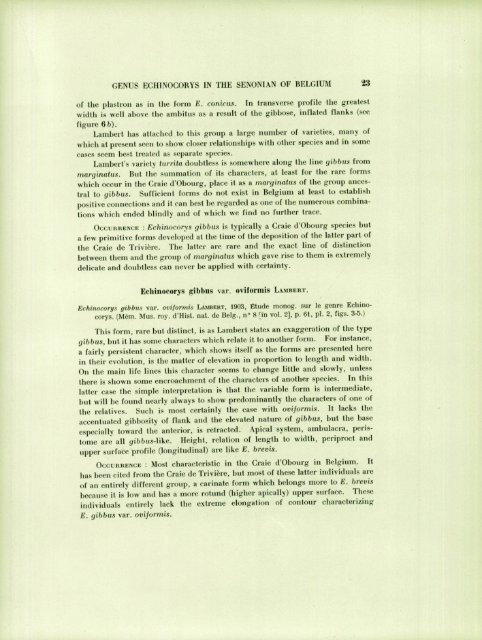ECIIINOID GENUS ECHINOCOIÎYS
ECIIINOID GENUS ECHINOCOIÎYS
ECIIINOID GENUS ECHINOCOIÎYS
You also want an ePaper? Increase the reach of your titles
YUMPU automatically turns print PDFs into web optimized ePapers that Google loves.
<strong>GENUS</strong> ECHINOCORYS IN THE SENONIAN OF BELGIUM 23<br />
of Hie plastron as in the form E. conicus. In transverse profile the greatest<br />
width is well above Hie ambitus as a result of the gibbose, inflated flanks (sec<br />
figure 6b).<br />
Lambert has attached to this group a large number of varieties, many of<br />
which at present seen to show closer relationships with other species and in some<br />
cases seem best treated as separate species.<br />
Lambert's variety turrita doubtless is somewhere along the line gibbus from<br />
marginatus. But the summation of its characters, at least for the rare forms<br />
which occur in the Craie d'Obourg, place it as a marginatus of the group ancestral<br />
to gibbus. Sufficient forms do not exist in Belgium at least to establish<br />
positive connections and it can best be regarded as one of the numerous combinations<br />
which ended blindly and of which we find no further trace.<br />
OCCURRENCE : Echinocorys gibbus is typically a Craie d'Obourg species but<br />
a few primitive forms developed at the time of the deposition of the latter part of<br />
the Craie de Triviere. The latter are rare and the exact line of distinction<br />
between them and the group of marginatus which gave rise to them is extremely<br />
delicate and doubtless can never be applied with certainty.<br />
Echinocorys gibbus var. oviformis<br />
LAMBERT.<br />
Echinocorys gibbus var. oviformis LAMBERT, 1903, Étude monog. sur le genre Echinocorys.<br />
(Mém. Mus. roy. d'Hist. nat. de Belg., n° 8 r in vol. 2], p. 61, pi. 2, figs. 3-5.)<br />
This form, rare but distinct, is as Lambert states an exaggeration of the type<br />
gibbus, but it has some characters which relate it to another form. For instance,<br />
a fairly persistent character, which shows itself as the forms are presented here<br />
in their evolution, is the matter of elevation in proportion to length and width.<br />
On the main life lines this character seems to change little and slowly, unless<br />
there is shown some encroachment of the characters of another species.<br />
In this<br />
latter case the simple interpretation is that the variable form is intermediate,<br />
but will be found nearly always to show predominantly the characters of one of<br />
the relatives. Such is most certainly the case with oviformis. It lacks the<br />
accentuated gibbosity of flank and the elevated nature of gibbus,<br />
especially toward the anterior, is retracted.<br />
Apical system, ambulacra, peristome<br />
are all gibbus-Wke.<br />
upper surface'profile (longitudinal) are like E.<br />
but the base<br />
Height, relation of length to width, periproct and<br />
brevis.<br />
OCCURRENCE : Most characteristic in the Craie d'Obourg in Belgium. It<br />
has been cited from the Craie de Triviére, but most of these latter individuals are<br />
of an entirely different group, a carínate form which belongs more to E.<br />
because it is low and has a more rotund (higher apically) upper surface.<br />
brevis<br />
These<br />
individuals entirely lack the extreme elongation of contour characterizing<br />
E. gibbus var. oviformis.

















